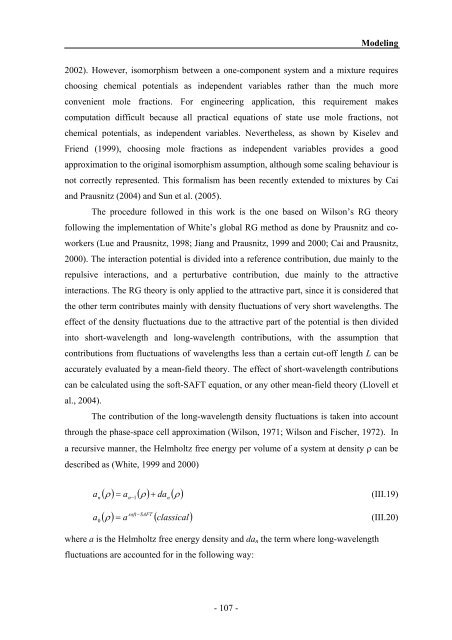n - PATh :.: Process and Product Applied Thermodynamics research ...
n - PATh :.: Process and Product Applied Thermodynamics research ...
n - PATh :.: Process and Product Applied Thermodynamics research ...
You also want an ePaper? Increase the reach of your titles
YUMPU automatically turns print PDFs into web optimized ePapers that Google loves.
Modeling<br />
2002). However, isomorphism between a one-component system <strong>and</strong> a mixture requires<br />
choosing chemical potentials as independent variables rather than the much more<br />
convenient mole fractions. For engineering application, this requirement makes<br />
computation difficult because all practical equations of state use mole fractions, not<br />
chemical potentials, as independent variables. Nevertheless, as shown by Kiselev <strong>and</strong><br />
Friend (1999), choosing mole fractions as independent variables provides a good<br />
approximation to the original isomorphism assumption, although some scaling behaviour is<br />
not correctly represented. This formalism has been recently extended to mixtures by Cai<br />
<strong>and</strong> Prausnitz (2004) <strong>and</strong> Sun et al. (2005).<br />
The procedure followed in this work is the one based on Wilson’s RG theory<br />
following the implementation of White’s global RG method as done by Prausnitz <strong>and</strong> coworkers<br />
(Lue <strong>and</strong> Prausnitz, 1998; Jiang <strong>and</strong> Prausnitz, 1999 <strong>and</strong> 2000; Cai <strong>and</strong> Prausnitz,<br />
2000). The interaction potential is divided into a reference contribution, due mainly to the<br />
repulsive interactions, <strong>and</strong> a perturbative contribution, due mainly to the attractive<br />
interactions. The RG theory is only applied to the attractive part, since it is considered that<br />
the other term contributes mainly with density fluctuations of very short wavelengths. The<br />
effect of the density fluctuations due to the attractive part of the potential is then divided<br />
into short-wavelength <strong>and</strong> long-wavelength contributions, with the assumption that<br />
contributions from fluctuations of wavelengths less than a certain cut-off length L can be<br />
accurately evaluated by a mean-field theory. The effect of short-wavelength contributions<br />
can be calculated using the soft-SAFT equation, or any other mean-field theory (Llovell et<br />
al., 2004).<br />
The contribution of the long-wavelength density fluctuations is taken into account<br />
through the phase-space cell approximation (Wilson, 1971; Wilson <strong>and</strong> Fischer, 1972). In<br />
a recursive manner, the Helmholtz free energy per volume of a system at density ρ can be<br />
described as (White, 1999 <strong>and</strong> 2000)<br />
( ) a ( ρ)<br />
da ( ρ)<br />
n ρ n<br />
n<br />
a = −1 +<br />
(III.19)<br />
a<br />
soft− SAFT<br />
( ρ ) = a ( classical)<br />
0 (III.20)<br />
where a is the Helmholtz free energy density <strong>and</strong> dan the term where long-wavelength<br />
fluctuations are accounted for in the following way:<br />
- 107 -



